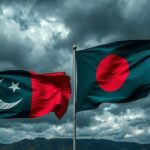Impact of U.S. Tariffs on Bangladesh’s RMG Sector and Market Competitiveness
The U.S. has imposed a 37% tariff on Bangladeshi products, elevating the total duty on cotton-blend garments to 54%. This move has raised alarms in Bangladesh’s $10 billion RMG sector, as the tariff rate now exceeds that of competitors like India. Industry leaders are advocating for policy adjustments to mitigate the economic impact and maintain competitiveness.
The recent imposition of a 37% tariff on Bangladeshi products by the United States has raised significant concerns among industry leaders, particularly within Bangladesh’s $10 billion ready-made garments (RMG) sector. This development is viewed as an unexpected challenge that could diminish the country’s competitive edge in the American market. The overall duty on RMG cotton-blend products has now risen to 54%, with Bangladesh facing one of the highest tariff rates globally, which places it at a disadvantage compared to competitors like India.
U.S. President Donald Trump announced the tariffs as part of a broader strategy to impose reciprocal tariffs equating to the duties placed on U.S. goods by other nations. This new policy was confirmed during a press event where Trump outlined the application of the 37% tariff on Bangladeshi products in response to retaliatory tariffs from Bangladesh.
Industry leaders, including Shovon Islam of Sparrow Group, have expressed concerns that these tariffs will encourage buyers to seek alternative sources in countries like Jordan, Egypt, and Kenya, where tariff rates are significantly lower. Furthermore, the immediate consequences of these tariffs may lead to shipment disruptions and payment delays, reminiscent of challenges encountered during the Covid-19 pandemic.
To alleviate the potential impact of this tariff hike, industry experts have proposed a dual approach for Bangladesh. One suggestion is to establish zero-duty access for U.S. agricultural products, thereby fostering direct procurement from the U.S. Instead of sourcing from countries like Brazil, this move could ease tensions in trade relations. Additionally, increasing imports of military equipment from the U.S. might help address the ongoing trade deficit.
Concerns were also raised regarding the formula used by the Trump administration to calculate these tariffs, which some industry leaders believe do not accurately reflect Bangladesh’s actual tariff rates. For instance, while Bangladesh’s trade deficit with the U.S. stands at $6.2 billion, this analysis contrasts sharply with the figure used by the U.S. administration.
As Bangladesh progresses towards graduation from Least Developed Country (LDC) status, the new tariff regime complicates this transition. Experts such as Shams Mahmud have indicated that these developments could undermine Bangladesh’s appeal to foreign companies, harming its tax revenues heavily dependent on import duties.
Furthermore, the new tariffs pose a considerable threat to Bangladesh’s RMG sector, as highlighted by Rakibul Alam Chowdhury, former BGMEA vice president. The sector is likely to face increased production costs and pressures from competitors like India and China, which may attract buyers seeking lower tariff rates. A reassessment of Bangladesh’s own tariff policies is imperative to negotiate more favorable terms with the U.S. and safeguard the interests of its RMG industry.
The imposition of substantial tariffs by the U.S. on Bangladeshi products is poised to significantly disrupt the RMG sector, jeopardizing trade dynamics and Bangladesh’s competitive advantage. Industry leaders advocate for strategic adjustments, including tariff recalibrations and a focus on enhanced imports from the U.S., to mitigate the adverse effects of these tariffs. As the country confronts this economic challenge, an urgent reevaluation of trade strategies is essential to secure its market position in the future.
Original Source: www.tbsnews.net








Post Comment